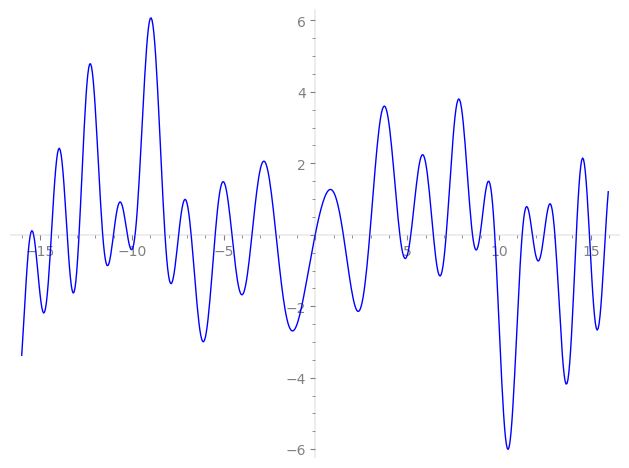| L(s) = 1 | + (−1.09 + 1.09i)3-s + (−0.913 + 4.91i)5-s + (0.925 − 6.93i)7-s + 6.59i·9-s + 4.54i·11-s + (−14.2 − 14.2i)13-s + (−4.38 − 6.38i)15-s + (−13.7 + 13.7i)17-s − 3.69i·19-s + (6.58 + 8.61i)21-s + (25.9 + 25.9i)23-s + (−23.3 − 8.97i)25-s + (−17.0 − 17.0i)27-s − 42.9i·29-s + 10.8·31-s + ⋯ |
| L(s) = 1 | + (−0.365 + 0.365i)3-s + (−0.182 + 0.983i)5-s + (0.132 − 0.991i)7-s + 0.733i·9-s + 0.413i·11-s + (−1.09 − 1.09i)13-s + (−0.292 − 0.425i)15-s + (−0.807 + 0.807i)17-s − 0.194i·19-s + (0.313 + 0.410i)21-s + (1.12 + 1.12i)23-s + (−0.933 − 0.359i)25-s + (−0.633 − 0.633i)27-s − 1.48i·29-s + 0.350·31-s + ⋯ |
\[\begin{aligned}\Lambda(s)=\mathstrut & 560 ^{s/2} \, \Gamma_{\C}(s) \, L(s)\cr =\mathstrut & (-0.724 + 0.689i)\, \overline{\Lambda}(3-s) \end{aligned}\]
\[\begin{aligned}\Lambda(s)=\mathstrut & 560 ^{s/2} \, \Gamma_{\C}(s+1) \, L(s)\cr =\mathstrut & (-0.724 + 0.689i)\, \overline{\Lambda}(1-s) \end{aligned}\]
Particular Values
| \(L(\frac{3}{2})\) |
\(\approx\) |
\(0.04128818463\) |
| \(L(\frac12)\) |
\(\approx\) |
\(0.04128818463\) |
| \(L(2)\) |
|
not available |
| \(L(1)\) |
|
not available |
\(L(s) = \displaystyle \prod_{p} F_p(p^{-s})^{-1} \)
| $p$ | $F_p(T)$ |
|---|
| bad | 2 | \( 1 \) |
| 5 | \( 1 + (0.913 - 4.91i)T \) |
| 7 | \( 1 + (-0.925 + 6.93i)T \) |
| good | 3 | \( 1 + (1.09 - 1.09i)T - 9iT^{2} \) |
| 11 | \( 1 - 4.54iT - 121T^{2} \) |
| 13 | \( 1 + (14.2 + 14.2i)T + 169iT^{2} \) |
| 17 | \( 1 + (13.7 - 13.7i)T - 289iT^{2} \) |
| 19 | \( 1 + 3.69iT - 361T^{2} \) |
| 23 | \( 1 + (-25.9 - 25.9i)T + 529iT^{2} \) |
| 29 | \( 1 + 42.9iT - 841T^{2} \) |
| 31 | \( 1 - 10.8T + 961T^{2} \) |
| 37 | \( 1 + (36.7 + 36.7i)T + 1.36e3iT^{2} \) |
| 41 | \( 1 - 30.7iT - 1.68e3T^{2} \) |
| 43 | \( 1 + (47.4 + 47.4i)T + 1.84e3iT^{2} \) |
| 47 | \( 1 + (39.0 + 39.0i)T + 2.20e3iT^{2} \) |
| 53 | \( 1 + (17.0 - 17.0i)T - 2.80e3iT^{2} \) |
| 59 | \( 1 + 93.6iT - 3.48e3T^{2} \) |
| 61 | \( 1 - 51.6iT - 3.72e3T^{2} \) |
| 67 | \( 1 + (-54.9 + 54.9i)T - 4.48e3iT^{2} \) |
| 71 | \( 1 - 50.1iT - 5.04e3T^{2} \) |
| 73 | \( 1 + (-1.87 - 1.87i)T + 5.32e3iT^{2} \) |
| 79 | \( 1 + 103.T + 6.24e3T^{2} \) |
| 83 | \( 1 + (51.9 - 51.9i)T - 6.88e3iT^{2} \) |
| 89 | \( 1 + 67.4T + 7.92e3T^{2} \) |
| 97 | \( 1 + (25.1 - 25.1i)T - 9.40e3iT^{2} \) |
| show more | |
| show less | |
\(L(s) = \displaystyle\prod_p \ \prod_{j=1}^{2} (1 - \alpha_{j,p}\, p^{-s})^{-1}\)
Imaginary part of the first few zeros on the critical line
−10.24373839164045780027961734375, −9.825705706591185002275734644225, −8.196676363090990773619782383977, −7.45403304167696752972694066461, −6.77089474995107431187207902335, −5.46284712178789691884877288750, −4.54720569547783718101579014940, −3.45831708535040820657472630628, −2.14770316612234271297708198608, −0.01619214900286153276859393792,
1.51895821156697674121809821020, 2.95931723961520995846443323034, 4.59709024695241460201758844268, 5.19349593581897361800160757544, 6.42121525219581221652636393742, 7.12121617657456254954073197639, 8.554710037072255440152945361397, 8.968741254956104399809356914918, 9.764648809690219159491926027193, 11.25914417600694703225200815860

